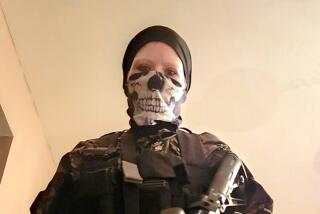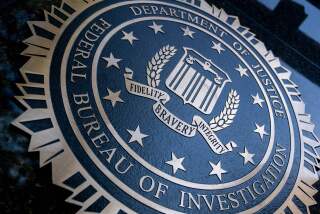Loner Likely Sent Anthrax, FBI Says
- Share via
WASHINGTON — The FBI is increasingly convinced that the person behind the recent anthrax attacks is a lone wolf within the United States who has no links to terrorist groups but is an opportunist using the Sept. 11 hijackings to vent his rage, investigators said Friday.
Based on case studies, handwriting and linguistic analysis, forensic data and other evidence, authorities do not believe at this point in their five-week investigation that Osama bin Laden’s Al Qaeda network was behind the anthrax attacks, FBI officials said.
Instead, FBI investigators said at a news briefing that they are probably looking for an adult male with at least limited scientific expertise who was able to use laboratory equipment easily obtained for as little as $2,500 to produce high-quality anthrax.
FBI officials, in offering their most expansive public assessment to date of their probe, are hoping that the rough profile they have developed of the anthrax culprit could produce a redux of their 1996 capture of the infamous Unabomber.
In that case, an 18-year rampage of bombings led authorities to Theodore Kaczynski only after his brother recognized his writing style in a lengthy manifesto that was released publicly.
In the anthrax case, the FBI is hoping its portrait of the perpetrator--as an antisocial loner with some peculiar mannerisms in his handwriting and phrasing--will help lead them to whoever mailed at least three anthrax-laced letters and killed four people.
Authorities have offered $1.25 million in reward money, and leads from the public “will play an integral role perhaps in identifying this individual,” said James R. Fitzgerald, an FBI profiler who worked on the Unabomber case.
Even as authorities sought the public’s help, Homeland Security Director Thomas J. Ridge acknowledged at the White House on Friday that progress in the probe has been frustratingly slow. “We’re still no closer to identifying specifically the origin of the anthrax and / or the perpetrators of that challenge that’s confronted America,” he said.
FBI officials acknowledge that psychological profiling, the stuff of “Silence of the Lambs,” is at best a rough science and it is not used often in soliciting tips from the public. But they insist they may have some telltale signs to follow by combining histories of serial bombers such as Kaczynski with handwriting and chemical evidence from three anthrax-laced letters sent in September and October to Senate Majority Leader Tom Daschle (D-S.D.), NBC anchor Tom Brokaw and the New York Post.
Investigators suspect, for instance, that whoever mailed the anthrax has little contact with the public and carries deep-seated resentments but does not like direct confrontation.
The individual demonstrates the same tendencies as serial bombers, who “don’t really enjoy face-to-face confrontation with someone to iron out a problem. They choose to do it long-distance,” Fitzgerald said.
All three letters were postmarked from Trenton, N.J., but postal officials indicated Friday that they no longer believe the letters were mailed from a residential postal route in Ewing, N.J., just outside the Trenton city limits.
They have broadened their search to a wider region in the Trenton area, but FBI officials said there is no assurance that whoever mailed the anthrax letters had any direct connection to that area. Fitzgerald noted that Kaczynski traveled 1,500 miles by bus from Montana to San Francisco in order to send several explosive packages.
Investigators believe the anthrax attacker had at least a limited background in science, is perhaps someone with a doctorate, a lab technician “or somewhere in between,” Fitzgerald said.
“He’s shown us he knows anthrax,” said an FBI supervisor who spoke on condition of anonymity. And forensic analysis indicates that the anthrax in the Oct. 9 letter sent to Daschle was much more highly refined than what was contained in the two letters sent to the media Sept. 18, officials said.
That refinement process would require only “basic laboratory equipment”--including a microscope, a centrifuge and a milling device. The equipment would be available in many labs or could be purchased for as little as $2,500, officials said. “You could do it on a shoestring,” the FBI supervisor said.
FBI investigators said they are tracking recent purchases of milling and other equipment and are also curious about whether the mailing of the three letters on Tuesdays--Sept. 18 and Oct. 9--could indicate something about the attacker’s work schedule or access to a lab. But investigators said the relative ease of getting the processing equipment--and the lack of information about what labs and research centers even possess anthrax--have hindered their efforts.
Although early speculation indicated the highly refined strain of anthrax could only have been produced by labs in the United States, Iraq or Russia, investigators now believe “it could be from anywhere,” one senior FBI official said.
Investigators are not ruling out overseas possibilities, but current evidence points to “no direct or clear linkage” to any known terrorist cells, Fitzgerald said. That would mean it was not linked to Bin Laden, Iraq’s Saddam Hussein or other Middle Easterners with known interest in bioterrorism.
One sign leading investigators away from the prospect of an Islamic fundamentalist is the use of the phrase “Allah is great” to close all three letters. Fitzgerald said the phrasing and the absence of Arabic text do not jibe with past terrorist attacks, and he suggested the author may have been trying to falsely cast suspicion on Middle Easterners.
All three notes also began with the date “09-11-01.” But again, Fitzgerald said there is a strong possibility the attacker was hiding behind the date of the Sept. 11 hijackings as subterfuge. The attacker appears to be “an opportunist [who] took advantage” of the mayhem surrounding the hijackings to pursue his own agenda, Fitzgerald said.
The pattern of evidence points to a home-grown terrorist, investigators said. “We’re certainly looking in that direction right now as far as someone domestic,” the FBI supervisor said.
The FBI is also hoping that oddities in the three letters, which authorities released last month, could jog the memory of someone else who has gotten a letter from the same author. The letters were written in distinctive block lettering with a downward slope, for instance, and the author used distinctive “1” numerals, along with dashes to write the “09-11-01” date instead of slashes, investigators noted. The author spelled penicillin incorrectly in the line “take penacilin now,” but Fitzgerald said this may have been an attempt to falsely “dumb down” the letter to throw investigators off the trail.
Postal authorities on Friday also revised their assessment of how a Hamilton, N.J., letter carrier may have contracted anthrax.
The FBI then believed Teresa Heller, 45, had probably handled one of the anthrax-laced letters. But once no anthrax spores were found at the small West Trenton postal branch where Heller worked, authorities were forced to reexamine the theory.
While anthrax hot spots have continued to be found at outlying New Jersey postal facilities, officials blamed the findings on cross-contamination and said the discoveries have been of little help in the investigation.
*
Times staff writers Edwin Chen, Robert A. Rosenblatt and Robin Wright in Washington and Janet Wilson in New York contributed to this report.
More to Read
Sign up for Essential California
The most important California stories and recommendations in your inbox every morning.
You may occasionally receive promotional content from the Los Angeles Times.











